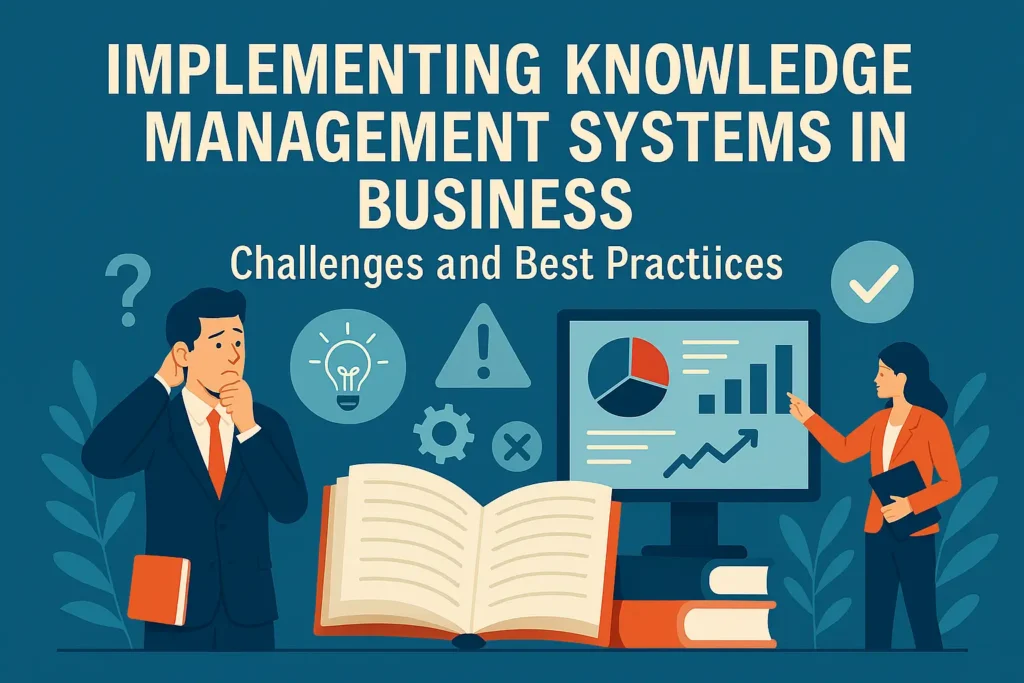Knowledge is the most valuable currency of modern enterprises. Yet, many organizations still struggle to capture, organize, and apply it effectively. A well-structured knowledge management system (KMS) can transform the way businesses operate by centralizing knowledge assets, improving collaboration, and accelerating decision-making. However, implementing such a system is rarely straightforward. It requires a balance of technology, strategy, and culture. This article explores the key challenges organizations face when implementing knowledge management systems in business and highlights best practices that ensure long-term success.

Why Knowledge Management Systems Matter in Business
A knowledge management system serves as the backbone of organizational intelligence. It allows enterprises to collect data, store insights, and provide access to critical information in real time. In business environments where speed and precision are paramount, knowledge management systems enable:
- Improved productivity by reducing time spent searching for information
- Consistent decision-making across departments through shared knowledge resources
- Enhanced customer service by ensuring frontline teams have instant access to accurate information
- Innovation and growth through knowledge reuse and collaboration across functions
Global leaders like Microsoft, Accenture, and Deloitte have invested heavily in KMS platforms to build smarter, more connected enterprises. The business case is clear: companies that manage knowledge effectively gain a competitive edge in both efficiency and innovation.
Challenges in Implementing Knowledge Management Systems
Despite their benefits, KMS implementations are complex. Businesses face several recurring challenges that often delay or derail initiatives.
1. Cultural Resistance
Employees may resist sharing knowledge due to fear of losing relevance or authority. A “knowledge hoarding” culture can significantly undermine a system designed to democratize information.
2. Technology Complexity
Choosing the right platform is often difficult. With a crowded market of knowledge management tools—ranging from SharePoint and Confluence to AI-driven platforms like Guru—organizations struggle to identify systems that integrate seamlessly with their existing infrastructure.
3. Data Quality and Governance
A knowledge system is only as strong as the information it holds. Outdated or inaccurate data leads to poor decision-making, which reduces trust in the system. Establishing data governance and regular content validation processes can be resource-intensive.
4. Lack of Clear Strategy
Some organizations deploy knowledge management systems without aligning them to business objectives. Without a strategy that ties KMS to measurable outcomes like faster onboarding or reduced support costs, adoption remains low.
5. Measuring ROI
Demonstrating the return on investment for KMS is another hurdle. Unlike traditional software, the benefits of knowledge management are often intangible—improved collaboration, faster decisions, or reduced errors—which makes it harder for leaders to justify the investment.
Best Practices for Implementing Knowledge Management Systems
Organizations that succeed with KMS do more than adopt technology; they build an ecosystem of processes and culture around it. Here are proven best practices:
1. Align with Business Goals
Before selecting a platform, define clear objectives. For example, if the priority is customer service, focus on systems that provide self-service knowledge bases and AI chat integrations. If the goal is innovation, prioritize collaboration features.
2. Secure Leadership Buy-In
Leadership commitment is critical to overcome cultural barriers. Executives must actively champion the system, use it themselves, and reward teams that engage in knowledge sharing.
3. Prioritize User Experience
A knowledge management system should be as intuitive as consumer apps. Poor usability is one of the biggest reasons employees avoid using KMS. Features like powerful search, mobile access, and personalized recommendations increase adoption rates.
4. Establish Governance and Maintenance
Appoint knowledge stewards or administrators to regularly validate and update content. Without governance, systems quickly become cluttered with outdated or duplicate information.
5. Foster a Knowledge-Sharing Culture
Encourage collaboration by embedding knowledge sharing into performance reviews, team KPIs, or recognition programs. Platforms like IBM’s Watson Knowledge Catalog succeed partly because they incentivize contributions.
6. Start Small and Scale Gradually
Instead of a company-wide rollout, start with a pilot program in one department. This allows businesses to gather feedback, refine processes, and build success stories before scaling.
7. Measure Success with Metrics
Track metrics such as reduced onboarding time, fewer duplicate support tickets, or faster project delivery. Linking these results to KMS adoption provides tangible proof of value.
Real-World Example: Accenture’s Knowledge Exchange
Accenture’s global workforce relies heavily on its internal Knowledge Exchange, which centralizes project insights, case studies, and best practices. The company overcame cultural resistance by embedding knowledge sharing into its performance evaluation system. It also invested in advanced search powered by AI to ensure consultants could find insights quickly. This combination of technology, culture, and governance has allowed Accenture to maximize the value of its KMS, setting a benchmark for other enterprises.
The Future of KMS in Business
Modern knowledge management systems are evolving with artificial intelligence and machine learning. Cognitive search, natural language processing, and predictive analytics are making it easier to deliver the right knowledge to the right person at the right time. As businesses continue to digitize, KMS will move from being a support tool to a strategic driver of innovation, resilience, and growth.
Final Thoughts
Implementing knowledge management systems in business is a complex but rewarding journey. The challenges—cultural resistance, governance, and technology selection—are real, but with a clear strategy and best practices in place, organizations can unlock the full potential of their knowledge assets. Companies that succeed will not only improve operational efficiency but also build a more agile, innovative, and future-ready enterprise.
Read: Knowledge Management Systems in Business: A Guide to Driving Growth and Efficiency
